Attitudes Towards Youth Crime and Willingness to Intervene: Findings from the 2006 Scottish Social Attitudes Survey
This report presents findings from a module of questions included in the 2006 Scottish Social Attitudes survey and revisits a theme first addressed by survey in 2004, namely public attitudes towards young people and youth crime.
CHAPTER FOUR AVOIDANCE BEHAVIOUR AND WILLINGNESS TO INTERVENE
Introduction
4.1. In this chapter, the focus shifts to the ways in which adults react to problematic situations involving young people. The analysis is based on three hypothetical scenarios posited in the course of the interview: one aimed at exploring 'avoidance behaviour' by adults when confronted by a gathering of teenagers; the second relating to willingness to intervene to prevent anti-social behaviour; and the last relating to willingness to intervene in the interest of a young person's safety.
Avoidance behaviour
4.2 Before moving on to consider willingness to intervene in problematic situations involving young people, it may be worth exploring briefly a related issue: namely, respondents' modification of their own behaviour in the face of a potentially threatening situation involving young people. All respondents were asked the following question:
I'd like you to imagine a situation in which you had to walk past a group of teenagers in order to get to a shop. Which of the answers on this card best describes how you might feel in that situation?
4.3 In tapping into adult concerns about encounters with young people and subsequent 'avoidance behaviour', this is clearly linked to the ability of individuals and communities to exercise informal social control. In many respects, avoidance behaviour can be seen as the flipside of willingness to intervene: if adults feel concerned about engaging with young people even in relatively unproblematic situations, it is reasonable to assume that they will also feel inhibited about involving themselves in situations in which young people are clearly posing a risk to others or are at risk themselves.
4.4 In terms of the wording of the scenario, it is worth noting that there is nothing to suggest that the young people concerned are behaving in an especially threatening or even boisterous way. The gender of the group is not specified.
4.5 Overall, around half of those interviewed said it would not bother them at all to walk past the teenagers and only around one in ten that they would feel very worried or uncomfortable or would probably avoid walking past them altogether. But there is also a very sizeable group who say they would feel 'slightly worried or uncomfortable' in such circumstances - an indication perhaps of the unease, rather than outright fear, that groups of young people can induce in much of the adult population.
Figure 8 - How feel about walking past group of teenagers to get to shop (%)
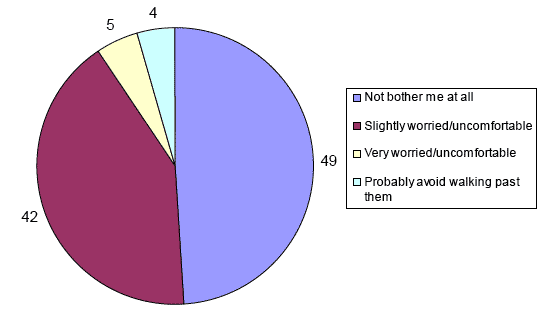
Sample size: 1589
4.6 It is also worth noting how responses to this question are patterned by age and gender. As the following graph shows, women in general - and older women in particular - are much more likely to say they would feel very worried/uncomfortable or avoid the teenagers altogether.
Figure 9 - Feel very uncomfortable/avoid altogether by age group and gender (%)
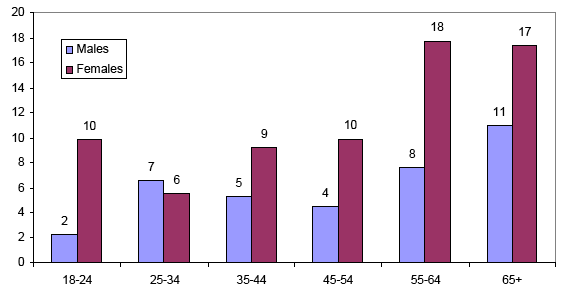
Sample size: 1589
4.7 Other variables that are independently associated with feeling 'not bothered at all' in such a scenario include the extent to which individuals have been directly affected by youth crime, general attitudes towards young people, extent of contact with 16 to 24 year-olds in the area, tenure 5 and area deprivation. In these findings, we start to see very clearly, in empirical rather than theoretical terms, the inter-relationships sketched out in the introduction. For example, 64% of those who say they know most of the 16 to 24 year-olds in their area say they would not be bothered at all, while the same is true of only 44% of those who say they know none.
Table 11 - Avoidance behaviour when faced with group of teenagers outside shop by key variables (row percentages)
Not bothered at all |
Slightly worried/ uncomfortable |
Very worried/ uncomfortable |
Avoid walking past altogether |
Sample size |
|
|---|---|---|---|---|---|
% |
% |
% |
% |
% |
|
All |
49 |
42 |
5 |
4 |
1594 |
Sex |
|||||
Male |
59 |
35 |
4 |
3 |
701 |
Female |
40 |
49 |
6 |
6 |
893 |
Age group |
|||||
18-24 |
45 |
49 |
3 |
3 |
108 |
25-34 |
51 |
43 |
3 |
3 |
222 |
35-44 |
49 |
43 |
5 |
3 |
325 |
45-54 |
52 |
41 |
3 |
5 |
270 |
55-64 |
49 |
38 |
8 |
5 |
270 |
65+ |
|||||
Urban-rural classification |
|||||
Large urban |
40 |
49 |
7 |
5 |
508 |
Other urban |
48 |
43 |
4 |
5 |
375 |
Accessible small towns |
53 |
32 |
4 |
11 |
187 |
Remote small towns |
60 |
36 |
4 |
1 |
113 |
Accessible rural |
56 |
40 |
3 |
1 |
219 |
Remote rural |
73 |
24 |
2 |
1 |
192 |
General attitudes towards young people |
|||||
Most positive |
62 |
33 |
3 |
3 |
530 |
Least positive |
39 |
47 |
8 |
7 |
516 |
Area deprivation |
|||||
Most deprived |
36 |
49 |
9 |
6 |
307 |
Least deprived |
57 |
38 |
2 |
4 |
318 |
Directly affected by youth crime |
|||||
Least directly affected |
64 |
31 |
2 |
3 |
516 |
Most directly affected |
34 |
48 |
10 |
8 |
466 |
Social trust |
|||||
Most can be trusted |
56 |
38 |
4 |
3 |
828 |
Can't be too careful |
41 |
46 |
7 |
6 |
700 |
Contact with 16 to 24 year-olds in area |
|||||
Know most |
64 |
30 |
3 |
3 |
241 |
Know none |
44 |
43 |
7 |
5 |
631 |
Tenure |
|||||
Owner-occupier |
49 |
44 |
3 |
3 |
1085 |
Social rented |
49 |
33 |
10 |
8 |
372 |
Willingness to intervene: risks posed by young people
4.8 In order to gauge adult willingness to intervene in situations involving risks posed by young people, respondents were asked to consider a situation in which they saw a group of 'fourteen year-old [boys/girls] you recognised damaging a bus shelter or other public property in your area'. Respondents were then asked to indicate how likely they would be to take each of a series of actions.
4.9 Several points are worth noting about this question. First, a random half of the sample was asked about boys and the other half about girls. In the analysis that follows, these two versions are both combined and treated separately to allow us to explore interactions between the gender of the young people. Secondly, the scenario explicitly assumes that there is some point of connection between the respondent and the young people concerned, through reference to recognising the young people and 'your area'. Thirdly, this question was included in the self-completion component of the survey and was affected by relatively high levels of item non-response, possibly because respondents thought they were being asked to indicate the action they would be most likely to take, rather than their likelihood of doing each one. While this may have affected the results, it is likely to have done so in ways that are broadly consistent across the sample. Hence the data still provide a reasonable basis for examining variations in response across different sub-groups.
4.10. We start by examining the responses of all respondents - i.e. by combining responses for those asked about 14 year-old boys and those asked about 14 year-old girls.
Table 12 - Likelihood of different actions in the face of teenagers vandalising bus shelter (%)
Challenge directly |
Talk to them later on their own |
Speak to their parents |
Call the police |
|
|---|---|---|---|---|
% |
% |
% |
% |
|
Very likely |
25 |
12 |
20 |
31 |
Fairly likely |
26 |
30 |
30 |
27 |
Not very likely |
22 |
26 |
23 |
22 |
Not at all likely |
24 |
27 |
21 |
15 |
Don't know |
4 |
5 |
6 |
5 |
Sample size |
1252 |
1087 |
1122 |
1214 |
4.11 There is by no means a clear consensus about the likelihood of taking each course of action - in relation to each, responses are fairly evenly spread - though the results do suggest that a majority of adults would take some kind of action in such a situation (setting aside, for the moment, the difference between a hypothesised scenario and real life decisions).
4.12 The proportion saying they would be 'very likely' to take a particular course of action was highest in relation to calling the police (31%), but this should not be taken as an indication that there is no appetite for informal intervention: a quarter said they would be very likely to challenge the young people directly and a fifth to speak to the young people's parents. The least likely course of action is speaking to the young people later when they are on their own - only 12% saying they would be 'very likely' to do this.
4.13 If we separate out the responses of men and women, we find a higher proportion of men saying they would be 'very likely' to challenge the young people directly. On the remaining three measures, there is no statistical difference between male and female respondents.
Figure 10 - 'Very likely' to take different actions (14 year-old boys/girls combined) by respondent's gender (%)
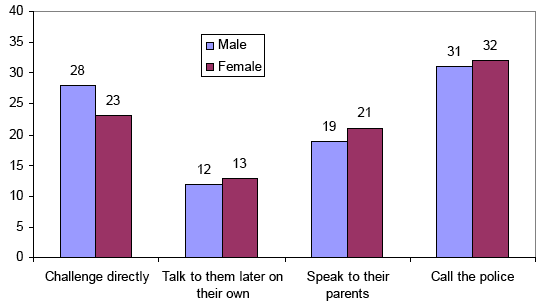
Sample size: 1087 - 1252
4.14 What happens if we now split responses according to the gender of the young people in the scenario? The following graphs show the proportions of male and female respondents 'very likely' to take each course of action, first in a situation involving 14 year-old boys, then one involving 14 year-old girls.
Figure 11 - 'Very likely' to take different actions (14 year-old boys only) by respondent's gender (%)
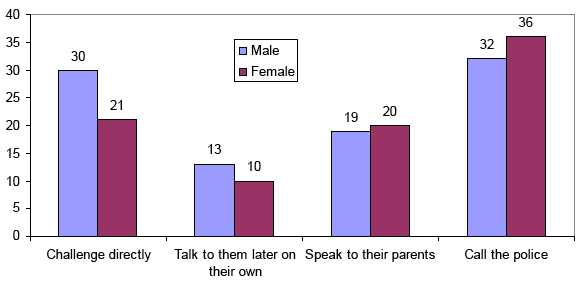
Sample size: 566 - 647
Figure 12 - 'Very likely' to take different actions (14 year-old girls only) by respondent's gender (%)
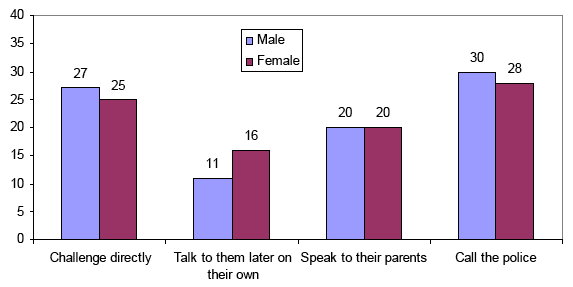
Sample size: 521 - 605
4.15 Male respondents are significantly more likely than females to say they would challenge directly a group of 14 year-old boys. In relation to the scenario involving 14 year-old girls, the difference is far less pronounced. Female respondents are more likely to intervene directly in a situation involving 14 year-old girls than one involving boys of the same age, and are also more likely to say they would talk to them later on their own. Both male and female respondents are slightly less likely to say they would call the police in a situation involving 14 year-old girls than one involving boys of the same age.
4.16 We will return to some of these gender effects below when we consider the reasons people give for any reluctance to intervene. First, however, we consider briefly the ways in which willingness to intervene varies along other dimensions.
Other predictors of willingness to intervene
4.17 Regression modelling suggests that inter-generational contact and general social connectedness are key predictors of willingness to intervene directly in such situations. For example, 35% of those in the 'most connected' group said they would be 'very likely' to challenge the young people directly, compared with 22% of those in the 'least connected' group. The same was true of 36% of those who said they know all or most of the 11 to 15 year-olds in their area, but of only 20% of those who knew none. Interestingly, however, these variables do not predict likelihood of calling the police. The following graphs shows the proportion of respondents saying they would be 'very likely' to challenge the young people directly by extent of contact with 11 to 15 year-olds in their area and overall social connectedness.
Figure 13 - 'Very likely' to challenge directly (14 year-old boys/girls combined) by level of contact with 11 to 15 year-olds in area (%)
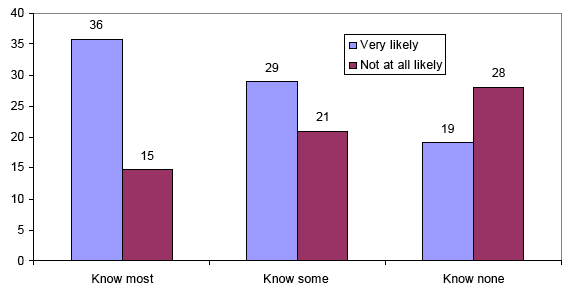
Sample size: 1086 - 1251
Figure 14 - 'Very likely' to challenge directly (14 year-old boys/girls combined) by social connectedness scale (%)
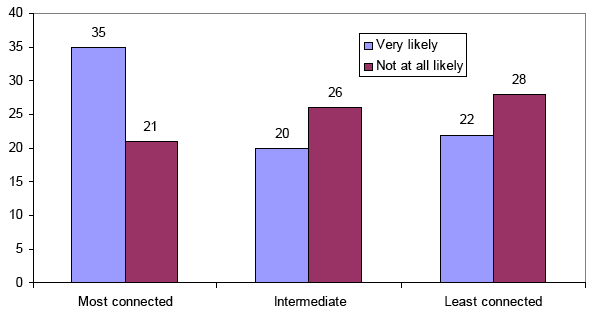
Sample size: 1085 - 1250
4.18 Although the differences are not that great, there is some evidence that these variables are even stronger predictors in relation to the specific scenario involving 14 year-old boys: for example, 40% of those knowing most of the 11-15 year-olds in their area said they would be very likely to intervene directly in such a situation, compared with just 16% of those knowing none.
4.19 There are also some interesting differences of note associated with settlement type. Essentially, those living in urban locations (and especially in large urban areas) are less likely to signal that they would intervene directly or call the police, while those in remote small towns and remote rural areas are more likely to do both. This suggests that processes of both informal and formal social control are stronger in remote rural areas. This supports the notion that effective community responses to crime and anti-social behaviour may involve both formal and informal dimensions, and indeed that one may support the other. This is a theme we return to in the conclusions.
Figure 15 - 'Very likely' to challenge directly or very likely to call police (14 year-old boys/girls combined) by urban-rural classification (%)
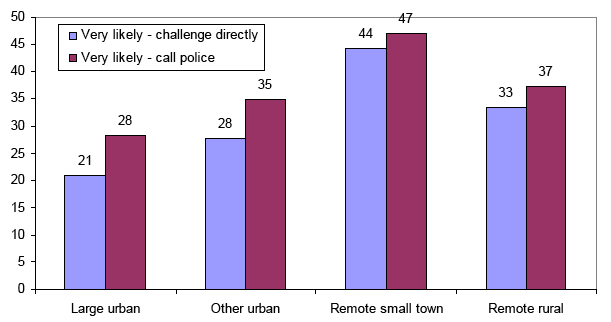
Sample size: 1150 - 1202
Reluctance to intervene
4.20 We turn now from what people say they would do to a consideration of why they might be reluctant to intervene directly in such situations. Regardless of their responses to the questions about their likely behaviour, respondents were asked the following:
Still thinking about this group of fourteen year-old [boys/girls], some people might be reluctant to speak to them directly. What, if any, concerns would you have about speaking to them directly? 6
4.21 The following table shows the most common responses for the sample as a whole ( i.e. for both versions of the scenario combined) and separately for those asked about 14 year-old boys and 14 year-old girls.
Table 13 - Reasons for reluctance to speak to teenagers directly by gender of teenagers (%)
Combined |
Girls |
Boys |
|
|---|---|---|---|
Would make no difference |
34 |
33 |
35 |
Might shout/threaten |
32 |
30 |
33 |
Might hit/assault |
30 |
23 |
36 |
Might allege threat or assault |
24 |
28 |
21 |
Might be laughed at |
17 |
18 |
16 |
Wouldn't have confidence |
10 |
10 |
10 |
No concerns |
23 |
26 |
19 |
Sample size |
1436 |
704 |
733 |
4.22 Several things are striking here. First, only around a quarter of all respondents (and even fewer of those asked to consider the scenario involving 14 year-old boys) say they would have no concerns about intervening directly. Secondly, although the most common response is simply that they would be reluctant to intervene because 'it would make no difference', there is also a sizeable group of respondents who indicate that they would be inhibited by the fear of actual or threatened violence, or by concern that they young people might make a false allegation of assault against them. Perhaps not surprisingly, concern about being threatened or assaulted is expressed more commonly in relation to the scenario involving boys, while concern about counter allegations is more common in relation to the scenario involving girls.
4.23 But the gender dimension can only be fully understood once the gender of the respondent is related to that of the young people specified in each scenario. As the following graphs show, for both male and female respondents, there are some important variations across the two scenarios.
Figure 16 - Reasons for reluctance to intervene directly (14 year-old girls only) by respondent's gender (%)
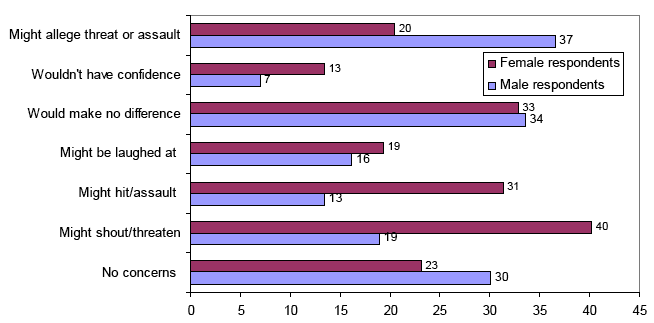
Sample size: 704
4.24 In relation to the scenario involving girls, female respondents were less likely than males to have 'no concerns' and much more likely to mention concern about actual or threatened assault. Male respondents, on the other hand, were much more likely to cite concern about false allegation as an inhibiting factor. Indeed this was the single most common response and was mentioned by almost 4 in 10 of all male respondents. The significance of this will be returned at various points in the remainder of the report.
Figure 17 - Reasons for reluctance to intervene directly (14 year-old boys only) by respondent's gender (%)
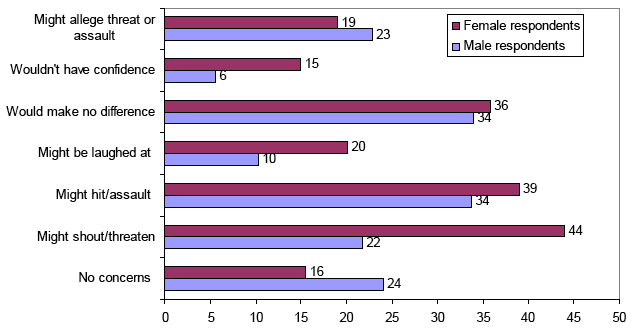
Sample size: 733
4.25 In relation to the scenario involving boys, female respondents were less likely to have 'no concerns' and more likely than male respondents to mention all of the other issues, with the exception of allegations of assault. They were twice as likely to cite concerns about being shouted at or threatened.
4.26 In summary, males are relatively less likely to have concerns about intervening in such situations, though only a minority say they would have no concerns. Both males and females are more likely to be concerned about violence or the threat of violence in situations involving boys than in situations involving girls. But for male respondents, the single biggest inhibiting factor in situations involving girls is the fear of wrongful allegations of assault.
4.27 Not surprisingly, those respondents with concerns about intervening are less likely to indicate that they would actually intervene; and the proportion of those with such concerns is, again, lower among those who know more of the young people who live in their area. The relationship with other variables is less pronounced.
Willingness to intervene: risks posed to young person
4.28 So far, we have focused on scenarios in which young people are engaged in anti-social behaviour or might otherwise be thought to pose a risk to other members of the community. The final scenario, by contrast, invited respondents to consider a situation in which a young person might be deemed to be at risk, and was worded as follows:
Now I'd like you to imagine another situation where you are coming home after dark at around 11pm. You see a ten year old [boy/girl], whom you don't know, playing on [his/her] own in a local park. Which ONE of these things do you think you would be most likely to do?
4.29 The sample was again split, with half the survey participants being presented with a version involving a 10 year-old boy and the other half a ten year-old girl. In this scenario, respondents were not given the cue of knowing or recognising the child, but the age of the child, the time of night and the fact it was dark were all intended to signal reasonable grounds for concern. The format of this question was slightly different in that respondents were not asked how likely they would be to do each of a range of things, but simply to indicate the thing they would be most likely to do.
4.30 As the following figure shows, around a third of all respondents said they would speak to the child directly, while slightly more indicated they would contact the police. Around one in five indicated that they would do nothing.
Figure 18 - Most likely action in scenario involving 10 year-old boy/girl (%)
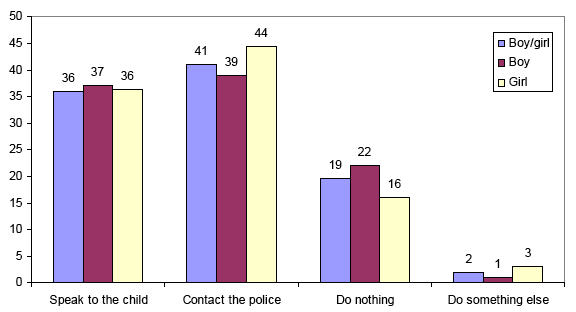
Sample size: 649 - 1329
4.31 If we take into account the gender of the child, some differences are evident - in particular, the fact that respondents seem more likely to contact the police (and correspondingly less likely to 'do nothing') in situations in which a girl rather than a boy is at risk. Overall, however, it appears that willingness to intervene is less strongly patterned by the gender of the young person than it was in the earlier example of the scenario involving vandalism.
4.32 The gender of the respondent is, however, a very important predictor here. Figure 19 shows the responses of male and female respondents for the two versions of the scenario combined. Figure 20 shows responses of male respondents only for the two versions of the scenario separately; Figure 21 shows the same for female respondents.
Figure 19 - Most likely action in scenario involving 10 year-old boy/girl by gender of respondent (%)
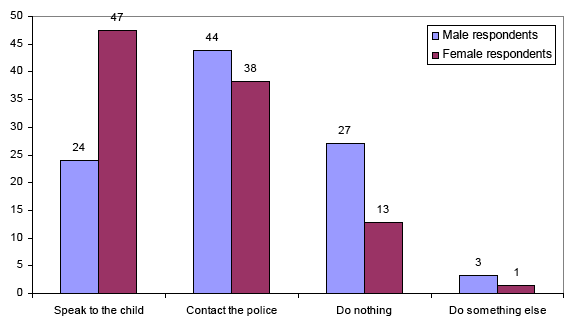
Sample size: 1329
4.33 Overall, it is clear that male respondents are twice as likely as females to say they would 'do nothing' in such a situation and around half as likely to speak to the child directly. But, again, it is necessary to combine the gender of the respondent with that of the child to understand fully what is going on here.
4.34 Once this is done, it becomes clear that male respondents are much less likely to intervene directly in a situation involving a ten year-old girl than a boy of the same age. For female respondents, the opposite is true. Consequently, there is a huge gap in the likely actions of men and women in relation to the scenario involving the ten year-old girl: just 18% of men say they would speak to the girl directly, compared with 52% of females. Although a higher proportion of men than women say they would contact the police (54% compared with 36%), a quarter of men say they would be likely to 'do nothing' in such a situation compared with just one in ten women.
Figure 20 - Most likely action in scenario involving 10 year-old boy/girl - male respondents only (%)
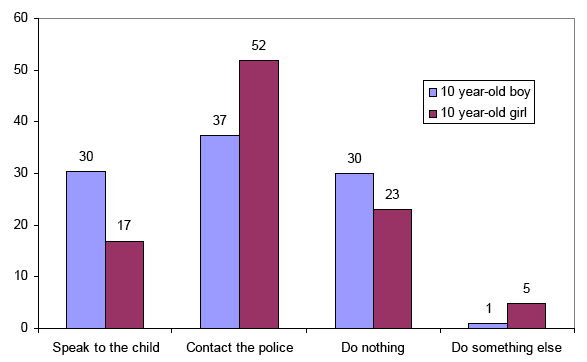
Sample size: 649 - 680
Figure 21 - Most likely action in scenario involving 10 year-old boy/girl - female respondents only (%)
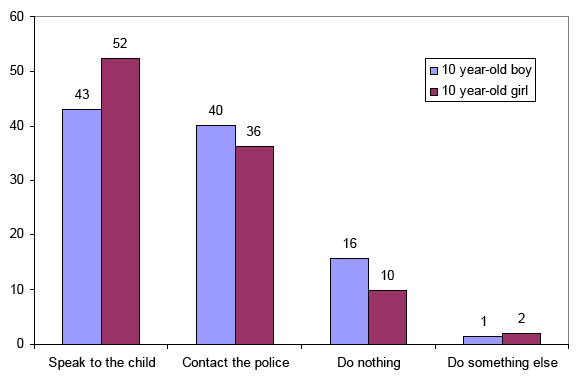
Sample size: 649 - 680
4.35 At first sight, this seems a curious finding. There is obvious concern about the well-being of the girl in the scenario, and male respondents are less likely to say they would do 'nothing' than in relation to a similar scenario involving a 10 year-old boy. Why, then, are male respondents so unlikely to approach the girl directly, and correspondingly more likely to call the police? We return to the factors that may lie behind these gender differences below.
4.36 Apart from gender, the other key predictors of willingness to intervene directly again relate to levels of inter-generational contact and social connectedness. The following figure shows the proportion of respondents who indicate they would speak directly to the child by these variables and suggests that those who know more of the young people in their area and have generally higher levels of social connectedness are much more likely to intervene.
Figure 22 - Most likely to speak to child directly in scenario involving 10 year-old boy/girl by contact with young people in area and social connectedness scale (%)
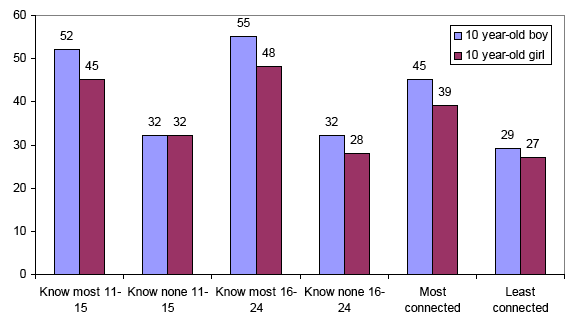
Sample size: 647 - 680
Reluctance to intervene
4.37 Again, regardless of their response to the initial question, respondents were asked about any concerns they might have about speaking to the child directly:
Still thinking about this same ten year-old [boy/girl], some people might be reluctant to speak to [him/her] directly in this situation. What, if any, concerns would you have about speaking to him directly?
4.38 The results for the scenarios involving the ten year old boy and girl are shown both separately and combined in the table below.
Table 14 - Reasons for reluctance to speak to child directly by gender of child (%)
Boy/girl combined |
10 year-old boy |
10 year-old girl |
|
|---|---|---|---|
No concerns |
35 |
38 |
33 |
Might shout/threaten |
5 |
7 |
3 |
Might hit/assault |
3 |
4 |
2 |
Might be laughed at |
3 |
3 |
3 |
Would make no difference |
9 |
11 |
7 |
Wouldn't have confidence |
5 |
5 |
5 |
Might allege threat or assault |
46 |
44 |
48 |
Sample size |
1395 |
713 |
682 |
4.37 Only around a third of respondents say they would have 'no concerns' about speaking to the child directly (in other words, most would have concerns of some kind). But in relation to both scenarios only one issue is mentioned by a sizeable number of respondents: namely, concern about false allegation of threat or assault.
4.38 Again, however, the full picture is only revealed if the gender of respondents is related to the gender of the child in the scenario. Although concern about threatened or actual violence is low overall, in relation to the ten year-old boy, it is markedly higher among female than male respondents. There is not a wide variation in levels of concern about allegations of assault - mentioned by half the male respondents and four out of ten females.
Figure 22 - Reasons for reluctance to intervene directly (10 year-old boy only) by respondent's gender (%)
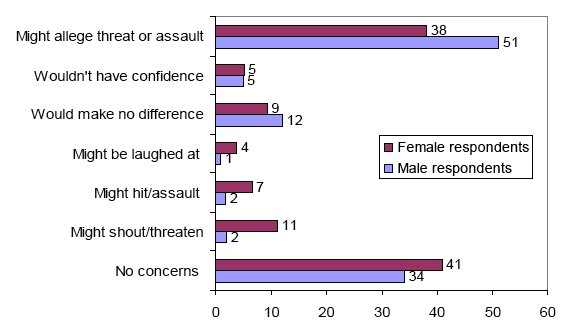
Sample size: 713
4.39 In relation to the scenario involving the 10 year-old girl, however, the differences between male and female respondents are much more pronounced. Perhaps the single most disturbing finding is that nearly two-thirds of male respondents say they would be reluctant to speak to a ten year-old girl in the circumstances outlined because of concerns about false allegations of threat or assault. The same was true for only around a third of female respondents. Only a fifth (21%) of males say they would have no concerns about intervening directly, compared with twice as many (43%) female respondents.
4.40 Overall, then, women are more likely than men to be concerned about threatened or actual violence - at least in relation to the scenario involving the 10 year-old boy - while men are much more likely to be worried about allegations of assault, especially in relation to the scenario involving the 10 year-old girl.
Figure 23 - Reasons for reluctance to intervene directly (10 year-old girl only) by respondent's gender (%)
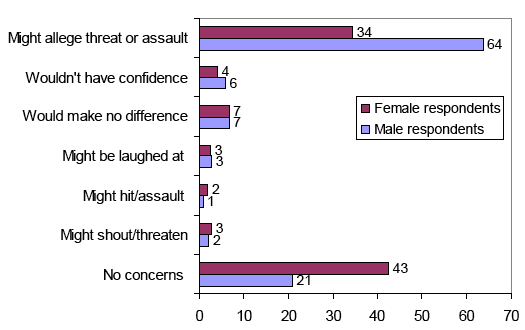
Sample size: 682
4.41 Whether or not adults know the young people in their area well enough to speak to them is a reasonable predictor of willingness to intervene. Interestingly, however, the degree of overall social connectedness is even more important. It may not be whether individuals know or recognise the young people causing problems that is the most important factor, but whether they are likely to know their parents. In other words, the most important thing may be to feel confident that one's actions will be understood and/or supported by other adults in the community. This is perhaps not surprising when set alongside the finding that concern about false allegation of assault is a key factor in discouraging adults from intervening in problematic situations involving young people.
Key points
- When asked to consider a scenario in which they had to walk past a group of teenagers to get to a shop, only a small proportion of adults (around one in ten) indicated that they would feel 'very uncomfortable' or would 'probably avoid doing so altogether'. But the fact that a further four in ten would feel 'slightly uncomfortable' is an indicator of the diffuse sense of unease that groups of young people can produce in adult members of the population.
- Moreover, among some sub-groups - such as women in general and older women in particular - the proportion saying they would feel very uncomfortable or avoid walking past altogether is significantly higher.
- In relation to a scenario in which a group of male or female teenagers were vandalising a bus shelter, there was wide variation in how likely respondents felt they would be to take different forms of action. The proportion saying they would be 'very likely' to call the police was higher than in relation to any other course of action, but sizeable numbers indicated that they would be likely to take some form of informal action, such as challenging the young people directly, speaking to them later or speaking to their parents.
- Men were more likely than women to say they would challenge the young people directly at the time, but were no more or less likely to take the other courses of action. And the difference in likelihood of intervening directly between male and female respondents is much greater in relation to the version of the scenario involving boys than the one involving girls.
- Otherwise, levels of inter-generational contact and general social connectedness are the most important predictors of willingness to intervene in this situation. People living in remote and rural communities are more likely both to intervene directly and to call the police, suggesting that formal and informal mechanisms can reinforce rather than replace each other in certain circumstances.
- Relatively few respondents said they would have 'no concerns' about intervening in such a situation, with a sizeable group inhibited by what they see as the possibility of threatened or actual violence.
- Both male and female respondents are more likely to worry about violence in the scenario involving a group of 14 year-old boys than the one involving girls, but for male respondents, concern about wrongful allegations directed against them is the predominant concern.
- When asked to consider a situation in which a ten year-old boy/girl was potentially at risk, around a third of all respondents said they would speak to the child directly while slightly more said they would call the police.
- But the interaction of the gender of the respondent with that of the child is critical here. Male respondents are much less likely to intervene directly in a situation involving a ten year-old girl than boy. For female respondents, the opposite is true.
- Male reluctance to intervene is overwhelmingly associated with concern about wrongful accusations of threat or assault - indeed, as many as 64% of men indicated that they might be reluctant to intervene for this reason in the scenario involving a 10 year-old girl - while female reticence is relatively more likely to be associated with concern about being threatened or assaulted.
There is a problem
Thanks for your feedback